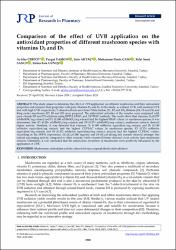| dc.contributor.author | Cebeci, Aybike | |
| dc.contributor.author | Taşkın, Turgut | |
| dc.contributor.author | Aktaç, Şule | |
| dc.contributor.author | Çam, Muhammet Emin | |
| dc.contributor.author | Sancı, Rıfat Sami | |
| dc.contributor.author | Güneş, Fatma Esra | |
| dc.date.accessioned | 2024-10-24T07:49:38Z | |
| dc.date.available | 2024-10-24T07:49:38Z | |
| dc.date.issued | 2024 | en_US |
| dc.identifier.citation | Cebeci, A.; Taşkın, T.; Aktaç, Ş.; Çam, M. E.; Sancı, R. S.; Güneş, F. E. Comparison of the effect of UVB application on the antioxidant properties of different mushroom species with vitamins D2 and D3(2024). Journal of Research in Pharmacy, 28(5):1508-1515. | en_US |
| dc.identifier.issn | 2630-6344 | |
| dc.identifier.uri | https://jrespharm.com/abstract.php?id=1697 | |
| dc.identifier.uri | http://dx.doi.org/10.29228/jrp.829 | |
| dc.identifier.uri | https://hdl.handle.net/20.500.12780/933 | |
| dc.description.abstract | This study aimed to determine the effect of UVB application on different mushrooms and their antioxidant
properties and compare their properties with pure vitamins D2 and D3. In the study, as without UVB, with medium UVB
and with high UVB, respectively; 3 ethanol extracts each from White button (E1, E2 and E3), Shiitake (E4, E5 and E6) and
King oyster mushroom (E7, E8 and E9) were prepared. The antioxidant activities of the samples were compared with
pure vitamin D2 and D3 solutions using DPPH, FRAP, and CUPRAC methods. The results show that vitamins D2 (0.277
mMFeSO4/mg extract) and D3 (0.380 mMFeSO4/mg extract) had the highest FRAP values. In mushroom species, it was
determined that E3 (0.216 mMFeSO4/mg extract) and E9 (0.273 mMFeSO4/mg extract) mushroom extracts showed
higher activity. Similarly, it was detected that vitamins D2 (0.609 mMrolox equivalent/mg extract) and D3 (1.149
mMrolox equivalent/mg extract) had the highest CUPRAC values. In mushroom species, E3 (0.324 mMrolox
equivalent/mg extract) and E9 (0.292 mMrolox equivalent/mg extract) extracts had the highest CUPRAC values.
According to the DPPH experiment, E6 (IC50:0.386 mg/ml) and E9 (IC50:0.411mg/ml) extracts showed stronger free
radical scavenging activity compared to other extracts, while vitamin D forms showed lower activity than mushroom
extracts. Ultimately, it was concluded that the antioxidant properties of mushrooms were positively influenced by the
application of UVB. | en_US |
| dc.language.iso | eng | en_US |
| dc.publisher | Marmara University | en_US |
| dc.relation.isversionof | 10.29228/jrp.829 | en_US |
| dc.rights | info:eu-repo/semantics/openAccess | en_US |
| dc.subject | Mushrooms | en_US |
| dc.subject | Antioxidant activity | en_US |
| dc.subject | Ultraviolet rays | en_US |
| dc.subject | Ergocalciferol | en_US |
| dc.subject | Cholecalciferol | en_US |
| dc.title | Comparison of the effect of UVB application on the antioxidant properties of different mushroom species with vitamins D2 and D3 | en_US |
| dc.type | article | en_US |
| dc.contributor.department | İstanbul Kent Üniversitesi, Fakülteler, Eczacılık Fakültesi, Eczacılık Meslek Bilimleri Bölümü | en_US |
| dc.contributor.authorID | https://orcid.org/0000-0001-5398-6801 | en_US |
| dc.contributor.institutionauthor | Çam, Muhammet Emin | |
| dc.identifier.volume | 28 | en_US |
| dc.identifier.issue | 5 | en_US |
| dc.identifier.startpage | 1508 | en_US |
| dc.identifier.endpage | 1515 | en_US |
| dc.relation.journal | Journal of Research in Pharmacy | en_US |
| dc.relation.publicationcategory | Makale - Uluslararası Hakemli Dergi - Kurum Öğretim Elemanı | en_US |


















